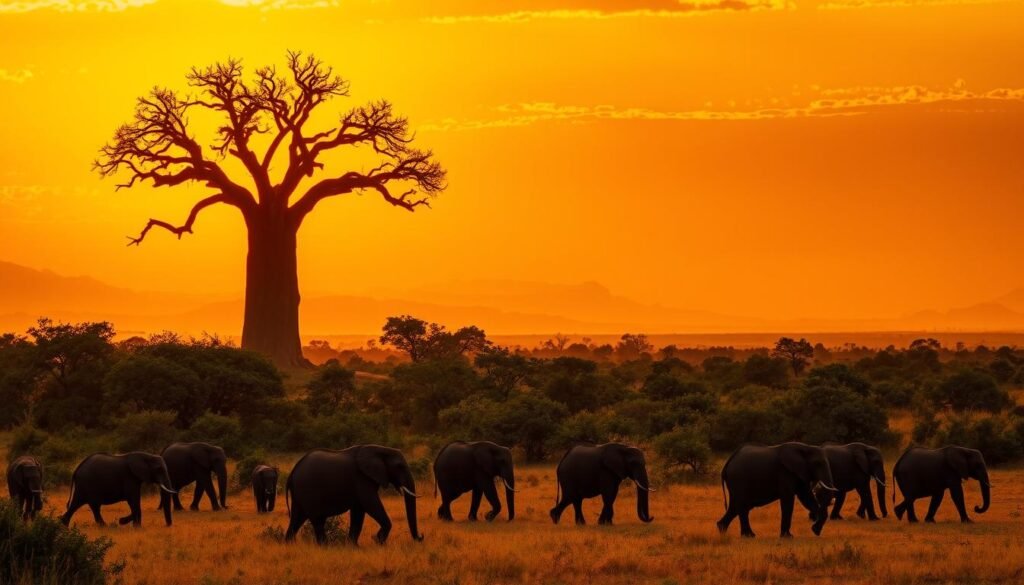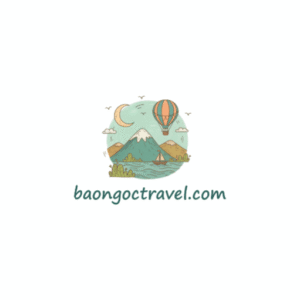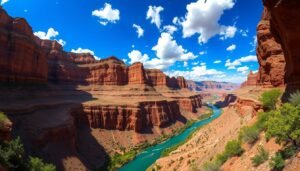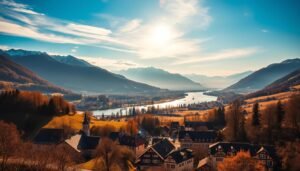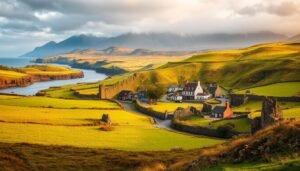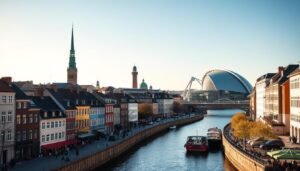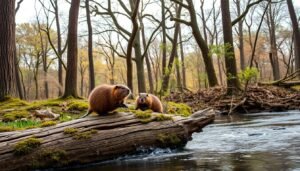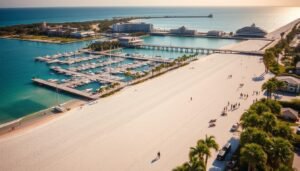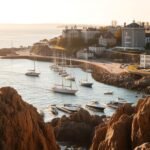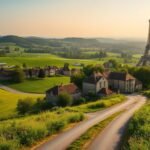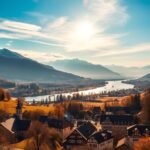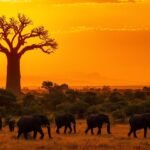Surprising fact: more than 2 million safari tourists head to sub-Saharan parks each year, and timing alters what you see as much as where you go.
I plan trips so you can narrow choices fast, whether you want a city break, a safari, or both in one itinerary. I start from Cape Town in South Africa more often than not because flights, cost, and logistics make it a smart way to string experiences together.
My approach balances time and budget with wildlife cycles. June–October is the dry season for game viewing in southern and east regions. January–February brings the Ndutu calving in the Serengeti, and April–May starts the Okavango flood.
I compare core safari ecosystems and national park options, and I give first-hand tips—when to add Victoria Falls, how to avoid crowds with a smart lodge choice, and the best way to combine city life and bush.
Key Takeaways
- I outline a fast planning method that matches season, budget, and trip style.
- Timing matters: dry season, calving, and floods shape wildlife viewing.
- Cape Town is a convenient gateway for city and safari combos.
- Smart lodge choice reduces crowds and improves sightings.
- Practical logistics—flights and border crossings—define the best way to connect sites.
How I choose the best places to visit in Africa right now

I focus first on your trip style and then align months and countries so your expectations are met.
User intent and trip style: safari, cities, beaches, or all three
I ask one direct question: do you want a classic safari, a city food trip, diving and beaches, or a mix? That answer sets the route and the likely time window.
Seasonality and wildlife first, everything else second
I plan around hallmark events: the wildebeest migration’s calving (January–February in Ndutu), the Okavango flood (April–May), and elephant peaks in September. I also avoid Mozambique during cyclone months.
“Timing makes the trip — a different month can mean entirely different wildlife and weather.”
- I match your time visit and time year to parks with strong guide reputations.
- I weigh logistics and the easiest way to link sites across a country or region.
- If months don’t align, I propose alternates that keep the same feel.
| Month | Highlight | Why I pick it |
|---|---|---|
| Jan–Feb | Ndutu calving | Mass predator action, dramatic births |
| Apr–May | Okavango flood | Water-based safaris and scenic floods |
| Sep | Chobe/Linyanti | High elephant concentration |
Best time to visit Africa for wildlife, weather, and value

Choosing when to go matters as much as where — it changes what you see each day. I use season windows to match wildlife cycles, weather, and budget so your trip delivers the moments you want.
Dry season (June to October): classic safaris and easy game viewing
The dry season concentrates animals at water. Short grass and scarce water make sightings predictable across national parks.best-places-to-visit-in-hawaii
Why I pick it: clearer roads, fewer mosquitoes, and the highest odds for big cats and large herds.
Green season (November to May): calving, birding, and lower prices
The green season brings dramatic skies, newborns, and migratory birds. I target Jan–Feb for Ndutu calving and superb birding in Botswana.
Value is real: luxury camps often discount rates in shoulder months without sacrificing wildlife action.
Month-by-month highlights: when I go for specific bucket-list moments
“I map the wildebeest migration arcs — Ndutu in Jan–Feb; central Serengeti from June onward — and plan accordingly.”
- Jan–Feb: Ndutu calving, intense predator behavior and birding.
- Mar–May: Okavango builds; April–May peak floods.
- Jun–Oct: peak dry season for consistent big-game sightings; Sept shines for Botswana elephants.
| Months | Highlight | Why I recommend |
|---|---|---|
| Jan–Feb | Ndutu calving | High predator-prey drama and newborns |
| Apr–May | Okavango flood | Water safaris and great bird life |
| Jun–Oct | Dry season | Easy game viewing across parks and reserves |
| May | Victoria Falls | Strong flows and improving game in Zimbabwe |
Cape Town, South Africa: the perfect city + nature kickoff
![]()
I often begin in Cape Town because it delivers a fast hit of culture, scenery, and easy logistics before the bush. A few days here sets expectations and helps me pace the rest of the trip.best-time-to-visit-bermuda
Table Mountain, beaches, wine country, and the Garden Route
Instant wow: Table Mountain views, V&A Waterfront energy, and quick drives to wine estates make this a top launch point. Walkable neighborhoods mean you see more on foot.
I plan a road leg along the Garden Route after several city days. Coastal scenery and wildlife stops ease the shift toward a national park or private reserve.best-caribbean-island-to-visit
Why I fly into Cape Town and how I pair it with safari
Flights, value, and choices make this the smart way into the country. I often connect onward to Kruger or a private reserve by a short domestic flight.
- I time stays to avoid strong Table Mountain wind and capture morning light.
- Day tours cover penguins, Cape Point, and wine tastings without self-drive stress.
- I match city time to your safari goals so travel days stay efficient.
Kruger National Park and beyond, South Africa

If you want wide-open plains and long self-drive loops, Kruger delivers; if you want guided off-road tracking, head for adjacent concessions.
I compare kruger national park options with private reserves like Sabi Sands and Timbavati. Kruger national gives scale and variety. Private reserves offer flexible off-road tracking and night drives.
For short trips I suggest Pilanesberg near Johannesburg or Addo Elephant National Park for strong elephant numbers and coastal add-ons. Visibility improves as foliage thins from May onward, so the dry months are a smart window.
- I match days: self-drive loops in the national park for independence, or guided lodges in private reserves for expert tracking.
- I mix nights in private concessions with Kruger rest camps when budget matters.
- I map road routes and note internal flights if you add Cape Town or Victoria Falls.
| Option | Why choose | Typical stay (days) |
|---|---|---|
| Kruger national park (self-drive) | Scale, public camps, flexible routes | 3–7 |
| Private reserves (Sabi Sands, Timbavati) | Off-road tracking, intimate sightings | 2–4 |
| Pilanesberg / Addo | Short transfers, Big 5/Big 7 highlights | 1–3 |
I flag malaria risk and seasonal gear needs. I schedule morning and afternoon game drives for predators and suggest lingering at hides during hot midday hours. Kruger gives breadth; private concessions give close encounters. I pick the mix that fits your time and budget in this country.
Victoria Falls, Zimbabwe and Zambia: the world’s smoke that thunders
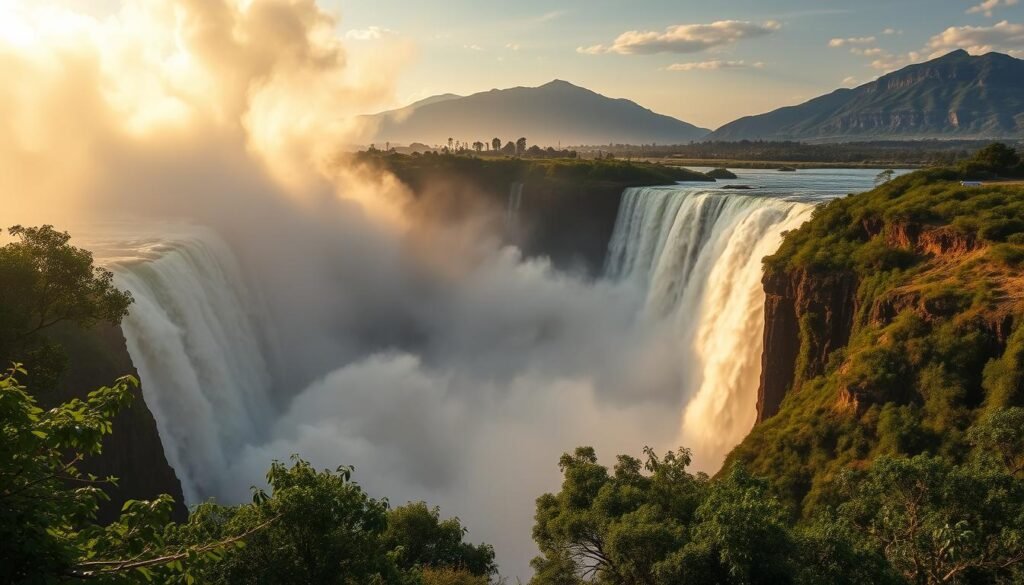
When I plan a trip to Victoria Falls I pick dates by river flow and the kinds of activities I want. The spray can be overwhelming in high water, and low flows expose Devil’s/Angel’s Pool on the Zambian side.best-cities-to-visit-in-spain
How I time flows, visas, and USD cash on arrival
I bring USD cash for many Zimbabwe visas; border officers often expect cash even if you prepay. I choose KAZA, dual, or single-entry visas based on whether I cross into Zambia.
“I time my visit around river levels: high water for thunder and spray, low water to get in Devil’s Pool.”
Helicopter flights, river cruises, and the pool
I add a helicopter Flight of Angels for the full perspective and a Zambezi sunset cruise for wildlife and light. I plan at least one full day at the falls and prefer two nights if I want every activity.
- I base on the side that suits my mood: Zimbabwe for classic viewpoints, Zambia for the pool and seasonal access.
- I arrange transfers and lodging near town to save time and keep logistics simple.
- I pack waterproof layers, a lens cloth, and quick-dry shoes for wet paths.
| When | What you see | Why I choose it |
|---|---|---|
| Late summer–autumn | Maximum flow and spray | Dramatic thunder and full curtain of water |
| Low-water months | Devil’s/Angel’s Pool access | Swim on the edge and see rock faces |
| 1–2 nights | Falls + helicopter + cruise | Enough time for key activities and transfers |
Note: I often link Victoria Falls with Chobe or Hwange safaris so travel between park systems is efficient and memorable. It’s one of the compelling reasons I include this site on a short visit to Africa.
Chobe National Park, Botswana: elephant capital and river safaris

I plan my Chobe stays so dawn finds me on the water while herds still move between floodplain and shade.
Why September shines (and how I avoid crowds)
September is late dry season and the numbers are incredible along the riverfront. Clear skies and cooler mornings make long sightings easy.
I avoid busy Kasane corridors by choosing lodges near quieter gates. That cut in traffic often means better encounters and calmer mornings at the water.
River cruises vs. game drives: what I actually see
I split my time between slow river cruises and game drives. On the water I capture elephants swimming and low-angle light for wide scenes.best-time-to-visit-alaska
On drives I switch to a telephoto for predators and plains animals. Guides point out lion ambushes at crossings and leopards in riverine trees.
“Sunrise and sunset on the Chobe River deliver the most consistent elephant action and rich birdlife.”
- Timing: schedule early mornings and late afternoons for the best game activity and light.
- Logistics: expert transfers handle border handovers so I spend more time watching wildlife.
- Gear: wide lens for herds on water; telephoto for drives.
| When | Why go | What I focus on |
|---|---|---|
| September | Peak elephant numbers | Riverfront herds, clear sightings |
| Late dry season | Concentrated wildlife | Sunrise cruises, predator searches |
| Stay choice | Quiet gates away from Kasane | Fewer crowds, first-on-scene mornings |
Okavango Delta and Moremi, Botswana: the ultimate water-and-land safari

The Okavango Delta’s mosaic of channels and islands delivers a safari that shifts between water and dryland within a single day.
April–May floods turn the wetlands into a birding and mokoro paradise. I plan those weeks when I want close-up water views and quiet canoe trips.
July–October brings receding water and peak game density. That time yields concentrated herds and higher predator encounters, including leopards along tree lines.
Activities and where I stay
I split nights between a wetland camp for mokoro excursions and a drier concession edge for high-impact game drives. Private concessions let me add off-road tracking, night drives, and walking safaris with fewer vehicles per sighting.best-places-to-visit
- I fly a scenic loop at golden hour for broad aerial views of channels and lagoons.
- Mokoro trips give a low, serene perspective and great bird soundscapes.
- Book early: top camps in this country fill quickly during prime months.
“Time your stay so the flood enhances ambiance without cutting you off from core game areas.”
| When | What I get | Why I choose it |
|---|---|---|
| Apr–May | Wetlands, mokoro, birds | Flooded channels and calm canoe trips |
| Jul–Oct | Peak game, predators | Concentrated sightings and strong predator action |
| Any | Scenic flights | Best views and photo perspective |
Etosha National Park, Namibia: pans, predators, and night waterholes
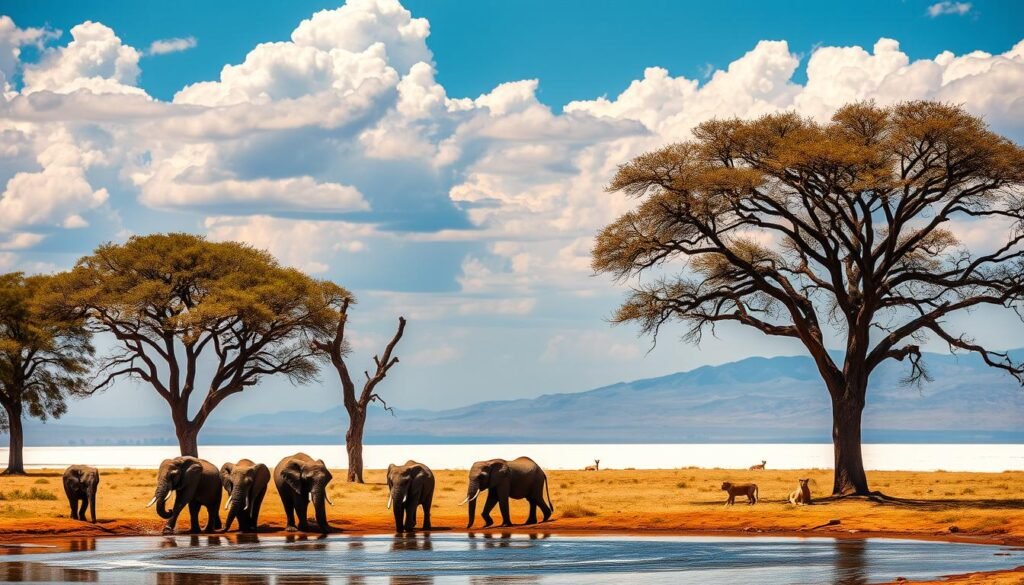
The open light and long vistas of Etosha create a safari rhythm I always build my route around.
Dry-season magic and how I plan a Namibia road trip
Etosha National Park shines in the dry season when animals crowd the waterholes on the salt pan’s edge. I plan my days so sunrise and sunset fall at key water points for the best activity and light.
I favor camps like Okaukuejo with floodlit waterholes; night viewing of predators and rhino can be unforgettable. Booking national park camps early is essential — availability is limited in peak months.
- I map a Namibia loop that links Etosha with Sossusvlei, the Skeleton Coast, and Damaraland’s desert wildlife.
- I schedule long drives with buffers for roadside sightings and plan fuel and provisioning stops carefully.
- I mix self-drive freedom with optional guided drives when I want targeted predator searches.
“Etosha rewards patience: the hours by a lone waterhole often deliver the most memorable encounters.”
I always carry binoculars for the distant pans. For me, this country’s wide roads and clear light make a road trip feel both calm and spectacular.
Serengeti and Ngorongoro, Tanzania: wildebeest on the move

I time my Serengeti legs around where the herd is likely to be, not the calendar alone.
January–February in Ndutu brings calving with more than 10,000 births a day and intense predator action. June–September shifts the focus north and west for river crossings and big drama.best-european-countries-to-visit
Calving vs. crossings
I pick Ndutu in Jan–Feb for relentless hunting scenes and newborns. Then I move north from June through September for the chance of river crossings.
Northern Circuit combos
I often weave Tarangire into the route for elephants and baobabs, and Lake Manyara for birds and tree-climbing lions. A day in Ngorongoro Crater gives concentrated Big 5 viewing.
- I use mobile camps to stay close to migration hotspots and maximize time near the wildebeest migration.
- I book experienced migration guides who read weather, grass, and river levels.
- Consider a dawn balloon tour over the plains for a unique tour perspective.
- I plan time visit around herd movement, accept nature’s variability, and build flexibility into the route.
“Crossings are never guaranteed, but good positioning and patience massively improve your odds.”
Masai Mara, Kenya: big cats, big skies, and seasonal drama
The Masai Mara draws me for its wide skies, close lions, and a rhythm set by herds and hunters.
I rely on the Mara conservancies when I want fewer vehicles and calmer sightings. Resident predators roam here all year, so excellent animal action is possible at many times.
Resident game year-round vs. migration timing
I time trips around the wildebeest migration window if river crossings matter, but I stress the steady presence of lions, cheetahs, and hyenas.
“Dawn and dusk drives reveal the most hunting scenes; mid-day is for rest, photos, or a cultural visit.”
- Conservancies: lower traffic, better big-cat photography.
- Timing: mid-year often brings migration herds from Tanzania; flexibility is key.
- Extras: add Kenya’s coast for warm water and beach days after your safari.
- Gear: bring a fast lens for low light and prepare for sudden afternoon showers.
- Community: respectful Maasai visits and private walking safaris offer a different travel pace.
| Feature | Why I choose it | When |
|---|---|---|
| Conservancies | Fewer vehicles, intimate sightings | Any |
| Migration focus | River drama and large herds | Mid-year |
| Coast add-on | Warm beaches and relaxation | Following safari |
Gorilla trekking in Uganda and Rwanda: my primate double take
Gorilla trekking asks for patience, fitness, and careful timing. I plan each trek around trail conditions, permit windows, and the goals I want from the encounter.
When I trek in Uganda vs. Rwanda
I tend to pick the drier months in Uganda — January–February and June–September — because trails are more stable and footing is safer.
Rwanda sometimes works better in shoulder months when permit availability improves and groups are smaller. Both countries have superb national park settings for gorillas, but each demands a slightly different schedule.
Adding chimpanzees: Kibale or Budongo
I usually add a chimp day in Kibale for high success rates or choose Budongo near Murchison Falls when I’m mixing primates with river safaris.best-time-to-visit-morocco
Permits are limited and must be booked early. Treks can be steep and muddy outside dry months, so I prep fitness and gear: layers, gloves, gaiters, and waterproof covers.
- Booking: I book gorilla permits as soon as dates lock—spaces are strictly controlled.
- Guides & porters: I use experienced porters for safety and local support.
- Health: I bring masks and follow rules to protect the gorillas’ health.
- Combine: I pair primate time with a short safari in Queen Elizabeth or Murchison for variety.
| Feature | Uganda | Rwanda |
|---|---|---|
| Peak months | Jan–Feb, Jun–Sep | Shoulder months, flexible when permits open |
| Trail conditions | Drier trails in peak months; muddy otherwise | Well-maintained but can be steep and wet |
| Permit advice | Book early from your home or agent | Book early; consider shoulder months for availability |
| Nearby activities | Chimp tracking (Kibale), savanna safari options | Chimp options limited; combine with local cultural visits |
“Meeting gorillas is a privilege—move calmly, keep distance, and savor every minute.”
Namibia’s icons beyond Etosha: Sossusvlei, Skeleton Coast, Damaraland
My Namibia routing links star dunes, wrecked hulls, and desert elephants on a compact but slow-paced road circuit. I favor April–May when rains have eased and temperatures start improving for outdoor photography and walking.
I plan a loop that begins at Sossusvlei for sunrise over the dunes and the surreal white clay pans of Deadvlei. I pick lodges near Sesriem gate so I am first into the dunes for cooler light and clearer photos.
Then I head northwest to the Skeleton Coast to shoot shipwrecks, fog banks, and roaring beaches. A detour through Damaraland brings encounters with desert-adapted elephants and ancient rock engravings.
- Logistics: I spread driving days, schedule fuel and grocery stops, and respect big distances.
- Balance: I mix guided desert ecology tours with self-drive freedom for flexible time on scene.
- Extras: Swakopmund offers summer flamingos, and Namibia’s dark skies rank among the world’s top spots for night-sky photography.
“I avoid rushing—this travel rewards a deliberate pace and deliberate stops.”
Finally, I often pair this loop with Etosha or fly onward to Botswana if a wildlife-heavy safari finale better suits the trip. The route also connects sensibly with regional maps that include national park options and easy links from south africa flights when needed.
Mozambique beaches and islands: Bazaruto, Quirimbas, and Tofo
For clear water and big pelagic encounters, I plan Mozambique legs around tide windows and calm-weather months. The coastline is a marine contrast after a land safari, with coral reefs, sandbanks, and slow island time that rewards relaxed travel.best-time-to-visit-aruba
When I go and where I dive
Avoid January–February — cyclone season brings heavy rain and rough seas. I target the dry season for calmer water, better visibility, and steadier boat runs.
- I split my days between Bazaruto (reefs and sandbanks) and Tofo (whale sharks during peak times), adding Quirimbas for remote island-hopping.
- I plan dives and snorkels around tides and sandbank picnics, and I pick lodges with PADI dive centers and solid safety records.
- I route flights via Johannesburg or Cape Town and leave buffers for domestic connections and occasional delays.
- I bring reef-friendly sunscreen, a rash guard, and flexible expectations — pelagics are wild, but timing windows improve odds.
- I often add a dhow sunset sail and suggest a short inland contrast like Victoria Falls before or after the beach for dramatic variety.
Lake Malawi and the Warm Heart of Africa
I trade long drives for island hopping, snorkeling, and lazy days on clear water at Lake Malawi.
I call this country a soulful pause—locals welcome you like home and small towns move at easy pace.
Where I stay: a few days at Cape Maclear or Nkhata Bay, plus an island night if I want off-grid calm.
“The Ilala Ferry is iconic—book loosely and enjoy the slow crossing rather than rush the schedule.”
What I do: I focus on snorkeling, kayaking, and sunset cruises, and I add light hikes or a Nyika detour for biking.
- I pick lodges with lake conservation and community links when possible.
- Public transport and backpacker hostels make local travel easy and budget-friendly.
- If time allows, I add Liwonde or Majete for a compact safari add-on.
| Stop | Why I pick it | Suggested days |
|---|---|---|
| Cape Maclear | Clear bays, snorkeling, night markets | 2–3 |
| Nkhata Bay | Island access, relaxed cafés, local culture | 2–4 |
| Island stay | Off-grid serenity, simple lodges | 1–2 |
Zambia’s wild side: South Luangwa, Lower Zambezi, and Livingstone
I love Zambia for its gentle, hands-on wildlife experiences and easy English communication. The country feels like home when I step out on a shaded trail or glide in a quiet canoe.
Walking safaris, night drives, and why I love South Luangwa
South Luangwa national park is famous for walking safaris and bold after-dark drives. I choose it when I want trackers who read spoor and small signs most others miss.
Lower Zambezi gives a different mood: canoeing, boating, and bankside elephant sightings. Combining both parks in one trip shows two sides of the same river system in a short span of time.
I add Livingstone for quick access to victoria falls and river activities on the Zambezi. Devil’s and Angel’s Pool are seasonal — I time that visit when water levels allow a safe dip.
“Walking close to scent trails and tracking at night gives me a connection with wildlife few other safaris offer.”
- I pick camps with strong guiding credentials; safety and local interpretation matter most.
- I plan night drives for leopard and hyena action and daytime walks for tracks and birds.
- I carry robust travel insurance including medical evacuation — remote national park travel can be unforgiving.
- I usually go in the dry season for concentrated game, though the green months offer great birding and lower rates.
- When I have extra days, Zambia is a natural part of a loop with Botswana or Zimbabwe for added variety.
best places to visit in africa: my one- or two-week first-timer itineraries
I lay out three compact itineraries that balance city life, iconic sights, and focused safari time. Each plan fits a roughly 8–12 day window and shows how I sequence flights, visas, and transfers so your trip flows without wasted days.best-time-to-visit-aruba
Cape Town + Victoria Falls + Chobe/Okavango
10–12 days: Fly into cape town (3 nights) for coast, wine, and a short city rhythm. Then a short international hop to victoria falls (1–2 nights) — bring USD cash for visas — before a transfer into Botswana for chobe national park and the okavango delta (4–5 nights). I schedule border handovers at Kasane and split camps between riverfront and wetland lodges. September often gives the strongest game density in Botswana.
8–10 days: Focus on the Northern Circuit—mobile or fixed camps near the herd for migration viewing, then a short flight to Zanzibar for beaches and spice tours. I lock dates by the wildebeest migration arcs and book balloon or crater mornings as highlight options.
Kruger + Panorama Route + Cape Town
10–12 days: Self-drive through kruger national park and the Panorama Route, then fly to south africa’s coast for Cape Town days. This combo mixes national parks and culinary city time. I advise where to splurge on guided game drives and where to save on lodging or travel timing without losing quality.
| Itinerary | Typical days | Why I pick it |
|---|---|---|
| Cape Town → Falls → Chobe/Okavango | 10–12 | City + scenic falls + high-density safari |
| Serengeti/Ngorongoro → Zanzibar | 8–10 | Migrations and a warm beach wind-down |
| Kruger → Panorama → Cape Town | 10–12 | Self-drive freedom and coastal culture |
Things I book early: permits, peak camps, and key internal flights. I also prepare alternates if a camp is full so your days stay intact and your budget remains under control.
Conclusion
Good timing and a clear goal turn a short trip into a lasting memory.
I focus on season windows and simple loops: June–October for dry-season concentrations, Jan–Feb for Ndutu calving, and April–May for the Okavango flood. Pick a month and the continent delivers dramatic numbers at waterholes and migration routes.
Start with a compact loop—Cape Town plus Kruger, or Cape Town then Victoria Falls and Chobe—and prioritize guiding and location over frills. That choice raises your odds of close sightings, from lions to leopards.
Handle visas, cash, and transfers early. When you’re ready, I’ll help stitch city, national park, and safari days into one best places shortlist that matches your time, budget, and sense of wonder.


